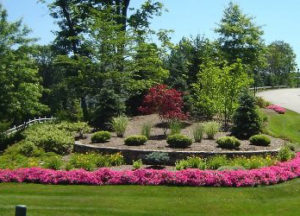
Improper spacing can lead to an overgrown landscape that’s unmanageable. When this occurs, plants will need to be uprooted and relocated elsewhere, but trying to relocate plants often leads to the death of the plant. In the end, this means replacing the barren space with new plant material, and possibly extra maintenance costs for taking care of the overgrown landscape.
Here are a few reasons why proper plant spacing is important to the health of your new landscape.
1. Plants Need Room to Grow to Maturity

Plants typically grow in all directions – up, down, sideways and diagonal. They spread their leaves to reach the sun, and roots to reach nutrients. Having space for shrubs and bushes is as important as giving room for fruits and vegetables to grow. In time, they’ll become the full, lush variety that you want them to be. Without room to grow, they can become mangled, dwarfed, or even diseased.
2. Plants Need Air and Sunlight to Defend Against Disease
Plants need an adequate amount of room to absorb sunlight, water, and nutrients. Signs of disease may not occur immediately, but when your plants run out of room to grow and start overcrowding each other, it becomes difficult to keep space clear and allow for sunlight and air to infiltrate the soil. This allows bacteria to be harbored and develop into fungus and decay.
When plants are in such close proximity to each other, disease is easily spread and can affect a majority of your newer landscape. There are some treatments available, but if your plants aren’t given proper spacing, the disease either won’t go away, or it will return and eventually kill the plants. This, again, leads to more costs in the end to remove material and replace it.
3. Properly Spaced Plants Are More Visually Appealing and Easier to Maintain
The reason you decided to renovate your landscape probably had something to do with the way it looked. Whether they are rich in color, perfectly sectioned, or desert-inspired, landscapes are visually appealing to us. We like to see clean cut yards with a touch of design.
This can also be the reason for pushing to have a full-grown landscape right away. But that visual appeal disappears when the plants continue to grow and become an over-grown tangled mass. It can become an eye-sore for you and a frustration for trying to maintain the vision that originally inspired you.
What to Expect from Your Landscape
Whether you are a homeowner, property manager, or HOA board member, it’s important to have the correct expectations when it comes time to change up the landscape. When the project is first completed, the landscape will look neat and crisp, possibly a little small with lots of space between each plant. This is perfectly normal, and the space will fill in.
Depending on what is being planted, plant material will typically come in a 1-gallon pot. Plants should be spaced three feet apart from the center root. This ensures that the material has plenty of room to settle its roots and grow upwards in the coming years. These specs also give the maintenance crew the proper amount of room they need to help nourish and maintain your new landscape.
Contact Us for More Information
If you have any questions regarding your current landscape, or would like to get a fresh perspective on an upcoming project, we would love to help! Give our office a call at 619-579-9151 or visit our contact page and let us know how we can assist you.


